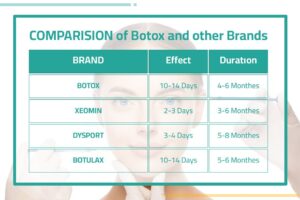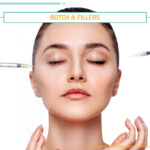Botox Injection
Let’s begin by defining Botox. Botox Injection is the brand name for the neurotoxin Onobotulinumtoxin A, which is produced by Clostridium botulinum. At present, the FDA has granted approval to four distinct varieties for the treatment of cosmetic facial wrinkles. Botox, Xeomin, Dysport, and Jeuveau are these.
All of them function by impeding a nerve signal to the specific muscle in question, thereby inhibiting its contraction. By inhibiting the contraction of these particular muscles, the epidermis experiences reduced tension or action, which in turn diminishes the rate at which wrinkles develop. Although these products all produce the same outcome, they vary marginally in terms of their initiation, duration of action, and level of irritation.
How Does Botox Function?
The timing of product usage is contingent upon a multitude of factors. Occasionally, the injector or surgeon may have a preference. In alternative cases, a patient might have experimented with various products and determined that one specifically functionsed better for them. Under the proper handling, each of these products is effective and secure.
Botox Injection is among the most recognizable brands of injections containing botulinum toxin. Toxins derived from botulinum are neurotoxins that impair muscles and impact nerves. A botulinum toxin injection may be administered for medical or aesthetic purposes. Injecting minute quantities of Botox into targeted muscles enables medical professionals to prevent migraine headaches, treat a variety of health conditions, and diminish the appearance of creases.
Botox inhibits muscle nerve signals. Muscles that have been infused are unable to contract (tense up). Although always temporary, these effects may persist for months. Which muscle is injected is determined by the area of primary concern. It is possible to treat multiple areas in a single session.
What to follow for Daily Skin Routine?
Botox Injection Uses
Botox is most frequently administered by physicians to diminish the appearance of facial creases. A Botox injection, however, can be used to treat additional conditions, including:
- Nervous disorder cervical dystonia is characterized by severe contractions of the muscles in the neck and shoulders.
- Extreme perspiration under the armpits (hyperhidrosis)
- Uncontrollable blinking, also known as blepharospasm
- Strabismus, or eyes that fixate on opposing points
- Persistent migraine
- Excessive bladder activity
What is the duration of a Botox injection?
The duration of Botox’s effects is three to six months. With the gradual resumption of muscular activity, lines and wrinkles begin to reappear and require further treatment. The diminishing of muscles over time frequently results in the appearance of less pronounced lines and creases.
What `re Botox Side Effects?
A transient occurrence of side effects is possible following a Botox injection. The following may be included:
- A bruise. This is a frequent adverse effect that resolves itself.
- A headache. These phenomena are uncommon and typically cease within a time frame of 24 to 48 hours.
- Eyelid adrenergicia. This phenomenon occurs in a minority of individuals and typically resolves itself within a span of three weeks. It typically occurs when the Botox is in motion; therefore, avoid rubbing the treated area.
- Crooked or gaping smile
- Dryness or intense tear production
- Mild inflammation or discomfort at the site of injection
- Flu-like symptoms or a pervasive sense of malaise
- Anxiety stomach
- Feeling of Numbness
- Deficiency in adjacent muscles
What can I anticipate throughout the Botox procedure?
Your healthcare provider injects minute quantities of Botox into the treatment area using a thin needle. Depending on the nature of the condition, multiple injections may be administered in various anatomical locations. What else should you be aware of regarding Botox therapy?
1. The administration of Botox requires an ambulatory visit. You will be permitted to return home that day.
2. Typically, discomfort is moderate. Although the injections may cause discomfort and pain, the procedure is completed rapidly. Prior to injecting, your healthcare provider may administer a topical numbing agent to your skin.
3. You might receive anesthesia. Injection therapy for an overactive bladder may involve the administration of local or regional anesthesia.
What is the need to know regarding Botox aftercare?
Unless otherwise instructed by your healthcare provider, you may resume work and the majority of other activities without delay following treatment. In order to diminish erythema, edema, or bruising:
- Maintain a standing position for three to four hours.
- Do not engage in any physical activity for twenty-four hours.
- Apply no pressure or rubbing to the treatment area for twelve hours.
Who Should Not to Use Botox?
Pregnant women, those who are nursing, and those with neurological disorders are contraindications for Botox use. Consult a physician upfront, as Botox is not effective against all creases.
How frequently must one get Botox?
The average duration of Botox’s effects is three to four months. A retreatment is currently advised. Your muscles may eventually develop the ability to contract less. Consequentially, extended intervals can be maintained between treatments. Your healthcare provider can estimate the frequency of Botox injections in accordance with your specific requirements.
Recovery
How long does Botox take to become effective?
The majority of individuals begin to observe the desired results of Botox treatment on the third or fourth day. Complete results will become apparent in ten to fourteen days.
How long does Botox last?
Three to six months following Botox treatment, muscles regain mobility and toxins have dissipated. Repercussions may include the return of wrinkles and vertigo, as well as increased perspiration. You may elect to sustain results through additional Botox injections. Your healthcare provider can advise you on the optimal frequency of Botox injections.
Types of Botox Brands
The active ingredient is botulinum toxin; however, the term “Botox” is commonly used to refer to nearly the entire class of medications comprising this class. Many individuals now use this term as a noun; for instance, “made Botox” or “scheduled an appointment for Botox.” Despite the fact that estheticians utilize a wide variety of muscle relaxants manufactured by various Botox brands, including American-made “Botox” medications. Additionally, there are Korean “Botulax,” German “Xeomin,” and French “Dysport” analogs.
Botox
The American trade name Botox® has come to represent all botulinum toxins. Long regarded as the only substance in cosmetology, Botox® eliminated wrinkles and rejuvenated the skin by means of its influence on the muscular system. The medication is significantly elevated in botulinum toxin. This enables the intended outcome to be accomplished with a reduced quantity of units in comparison to analogous preparations.
Dysport
A product of French origin, Dysport is one of Botox®’s most formidable competitors. In addition to human albumin and botulinum toxin type A, the substance also comprises lactose as an auxiliary constituent.
Xeomin
Xeomin German “Botox” is composed of albumin, sucrose, and botulinum toxin type A. Protein-free Xeomin is distinguished from its predecessors by the fact that it virtually eliminates the possibility of an allergic reaction.
The Botulax
It is the most well-known Botox brand in Korea. Botulinum toxin was first identified in Korea. Human albumin, Botulinum toxin type A, and sodium chloride are its constituents.

Why Should You Get Porcelain Dental Implant?
What is the distinction between fillers and Botox?
Botox and fillers are dissimilar in their essential nature. The first “freezes” the expression lines, or puts the facial musculature at rest in those regions. Consequently, the progression of scowl lines is halted, rendering them less conspicuous. Nevertheless, the deformity remains in place.
Fillers produce an alternative effect. They supplement the injection sites with volume. This can manifest in two ways: by directly filling in the wrinkle (as in the area between the eyebrows), or by altering the facial contours (hence the name contour plastics). For instance, one may elevate the cheekbones and slightly accentuate the jawline. Typically, the cosmetologist chooses a unique treatment plan to address particular concerns: In certain areas, Botox is used to relax muscles, while in others, fillers are used to add volume.
Which Botox brand has the greatest duration?
The degree to which the effects of “beauty shots” endure is contingent upon the specific attributes of the individual’s physique. Wrinkles and “creases” are statistically diminished for three to four months. Afterwards, if preferred, the procedure should be repeated.
Four to six months is the duration of action of the American pharmaceutical Botox. Additionally, both German Xeomin and Korean Botulax assert a maximum six-month duration of action. Five to eight months is the duration of effect attributed to the French drug Dysport, according to studies.
What distinguishes Botox type B from type A?
Only type A and type B serotypes of botulinum toxin are authorized for cosmetic applications. Botulinum toxin categories A and B differ in preparation for use, including dilution, injection procedure, specific mechanism of action, duration of effects, cost of treatment, and additional factors, in addition to their composition.
Is there different grades of Botox?
No varieties of Botox exist. Botox is packaged in a container as a powder. The capacity of the container ranges between 100 and 200 units of the substance. Prior to performing the injection, the physician saturates the substance with saline solution.
Botox Cosmetic Near Me at Natural Beauty Turkey?
When should I contact my medical professional?
Botox is a prevalent procedure that infrequently gives rise to severe adverse effects. Nonetheless, you should promptly contact your healthcare provider if you experience:
- Vision impairments, such as myopia or a downward sagging of the eyelids.
- A urinary tract infection may manifest as hematuria, or the presence of blood in the urine.
- Dyspnea, or breathlessness.
- Difficulty ingesting.
- Slurred language.
- Untreated area paralysis or numbness.
- Irritable abdominal pain.
Does Botox Hurt?
Injection needles for Botox are exceedingly minuscule. Consequently, the majority of patients encounter minimal to no discomfort throughout the course of treatment. Certain individuals report experiencing a mild stinging or constricting sensation. A topical numbing gel may be applied by your healthcare provider if you are concerned about discomfort.
Is Botox Safe to Use During Pregnancy?
Your infant is not likely to be harmed by Botox injections. Nevertheless, the majority of medical professionals advise delaying treatment until after delivery.
Is Botox Compatible with Bread Feeding?
Concerns remain regarding the presence of Botox in breast milk. In order to safeguard the well-being of the infant, the majority of medical professionals discourage the use of Botox injections during lactation.





